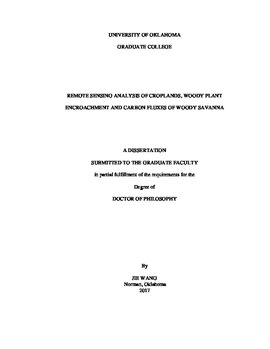| dc.description.abstract | Since 1990s, much attention has been paid to Land use/land cover change (LULCC) studies because it is an important component of global change. The vegetation change is a critical factor of land cover changes, which interacts with climate, ecosystem processes, biogeochemical cycles and biodiversity. Remote sensing is a good tool to detect the changes of land use and land cover. To date, most of studies on vegetation changes have been conducted at biome scales, but have not examined changes at the species level. This lack of studies on species inhibits analysis of ecosystem functions caused by the shifts of vegetation types. This dissertation aims to explore the potential of remote sensing images to produce long-term products on specific vegetation type and study the interactions between vegetation type, climate and gross primary production.
In Chapter 2, a simple algorithms was developed to identify paddy rice by selecting a unique temporal window (flooding/transplanting period) at regional scale using time series Landsat-8 images. A wheat-rice double-cropped area from China was selected as the study area. The resultant paddy rice map had overall accuracy and Kappa coefficient of 89.8% and 0.79, respectively. In comparison with the National Land Cover Data (China) from 2010, the resultant map had a better detection of the changes in the paddy rice fields. These results demonstrate the efficacy of using images from multiple sources to generate paddy rice maps for two-crop rotation systems.
Chapter 3 developed a pixel and phenology-based mapping algorithm, and used it to analyze PALSAR mosaic data in 2010 and all the available Landsat 5/7 data during 1984-2010. This study analyzed 4,233 images covering more than 10 counties in the central region of Oklahoma, and generated eastern redcedar forest maps for 2010 and five historical time periods: the late 1980s (1984-1989), early 1990s (1990-1994), late 1990s (1995-1999), early 2000s (2000-2004), and late 2000s (2005-2010). The resultant maps clearly illustrated an increase in red cedar encroachment within the study area at an annual rate of ~8% during 1984-2010.
Chapter 4 investigates the dynamics of juniper encroachment on the grasslands of Oklahoma by generating multi-period maps of juniper encroachment from 1984 to 2010 at a 30-m spatial resolution. The juniper forest maps in 1984 to 2010 were produced by the algorithms developed in Chapter 3. The resultant maps revealed the spatio-temporal dynamics of juniper forest encroachment at state and county scales. This study also characterized the juniper forest encroachment by geographical pattern and soil conditions. The resultant maps can be used to support studies on ecosystem processes, sustainability, and ecosystem services.
Chapter 5 compared dynamics of major climatic variables, eddy covariance tower-based GPP, and vegetation indices (VIs) over the last decade in a deciduous savanna and an evergreen savanna under a Mediterranean climate. The relationships were also examined among VIs, GPP, and major climatic variables in dry, normal, and wet hydrological years. GPP of these two savanna sites were also simulated using a light-use efficiency based Vegetation Photosynthesis Model (VPM). The results of this study help better understanding the eco-physiological response of evergreen and deciduous savannas, and also suggest the potential of VPM to simulate interannual variations of GPP in different types of Mediterranean-climate savannas. | en_US |
